In this desert of America, stowaways keep dying.
Produced by new york Time.
Welcome to reprint, please standardize your signature and add WeChat official account business card.
Source: USA Today
Translation: Juan
Editor: Jiangnan
[translator’s note]
On Monday (June 27th), the bodies of more than 40 immigrants were found on an overheated trailer on an industrial road in the south of San Antonio. The death toll has climbed to 51.
For decades, deaths have not been uncommon on this busiest smuggling route. Nevertheless, the staggering number on Monday, more than any one in recent memory, shocked law enforcement agencies and immigration advocates.
This scale may reflect that the border is now closed more than at any time in history, and people are beginning to look for more dangerous ways to cross the border, including smuggling in the hot summer season. The death toll has also started to rise. In 2021, at least 650 migrants died crossing the US-Mexico border, more than in any year since the United Nations-affiliated International Organization for Migration began tracking data in 2014.
In this article, the reporter is concerned about another cross-border route located in Arizona, which is in a hot desert. Without snakeheads and extra water, the chances of stowaways surviving are almost zero. So why do people risk crossing the border?
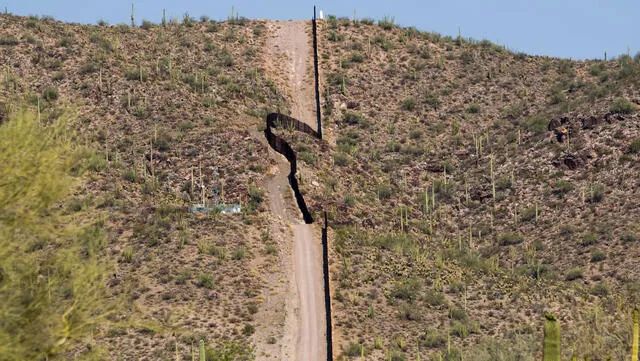
Borders and border walls in the desert.
The Supreme Court has undergone a fundamental change.
On the map, the desert in southwest Arizona is an empty land, the area of which is equivalent to that of Connecticut, a sea of nothingness.
On the map of death, it is a red ocean.
For those who are determined to enter the United States, this is a way out: a fence that can be crossed, an empty land that few people pay attention to, and a promise to the north. But in reality, if there is no snakehead as a guide and no additional water source is found, there is no way to cross.
So people die here and keep dying.
Selene Ramirez has obviously never hiked in the desert. On a day when the temperature will soar to 108 degrees Fahrenheit at the end of June, Ramirez carried her small backpack on her back, and obviously she didn’t have enough water to walk for five hours.
However, several illegal immigrants who passed by reported that there was a body in the desert. Ramirez is worried that this is the body of her 25-year-old brother carlos martinez. He crossed the border illegally in mid-June, and then he lost contact.
If it belongs to her brother, Ramirez is determined to find it.
"Some people think they are just illegal immigrants trying to cross the border. They don’t realize that they are human beings, and their families are thinking about them, "Ramirez said, taking the first step, walking into the furnace-like heat to seek answers.
More people died in the desert.
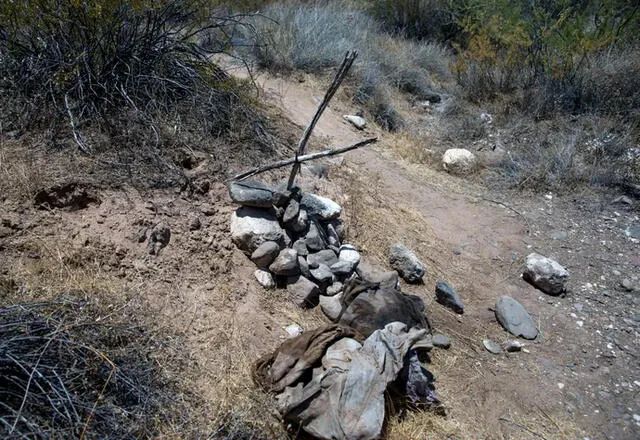
A hastily made cross represents the end of a stowaway’s journey here.
According to the Arizona Dead Immigrant Action Organization, since 2001, at least 2,832 bodies of immigrants have been found in southern Arizona. Nearly 40%(1089 people) have never been identified.
This initiative is a joint project of Humane Borders in Tucson and Pima County Medical Examiner’s Office. The project marks the location of every dead immigrant found on an interactive map. There are many red circles on the map, and southern Arizona is like a sea of blood.
But Chelsea Halstead, deputy director of the Corebury Center for Human Rights, said that the area has not always been a huge graveyard for immigrants. According to the data of OpenGIS, before 2000, fewer than five people were found dead every year in southern Arizona.
However, in 2001, with the surge of undocumented immigrants from Mexico to the United States and the strengthening of border security measures in California and Texas, more immigrants entered the United States through more remote and dangerous routes in Arizona, and the number soared to 79.
In 2010, 224 human remains were found, reaching the peak.
Since then, the number of arrests by the Border Patrol, which represents the number of people crossing the border illegally, has dropped significantly. Despite this, according to OpenGIS data, the number of immigrant deaths found every year is still high, with 169 people found in 2016.
Horstead said that the data showed that more people chose more dangerous routes and crossed more dangerous terrain.
Horstead said: "What we know is that people will find a way (through) with or without walls."
"What we can predict is that more people will be put in danger … more of them will die in the desert."
When Ramirez reported her brother’s disappearance, the center had 2,454 cases of missing immigrants reported by family members within the border. Among these immigrants, 1,560 are missing in Arizona, 286 in Texas, 80 in California and 4 in New Mexico. The rest just disappeared on the border, but I don’t know the exact location.
Ramirez said that her brother carlos martinez has lived in Arizona almost all his life. Their mother brought him to America illegally when he was nine months old. Four years later, Ramirez was born in Phoenix, so she is an American citizen, but her brother is not.
Ramirez said that his brother regards Arizona as his home. He tattooed "AZ" on his left shoulder. She said he was funny and caring, and often stopped to buy a snack for the homeless people in the street.
But in 2016, her brother was deported.
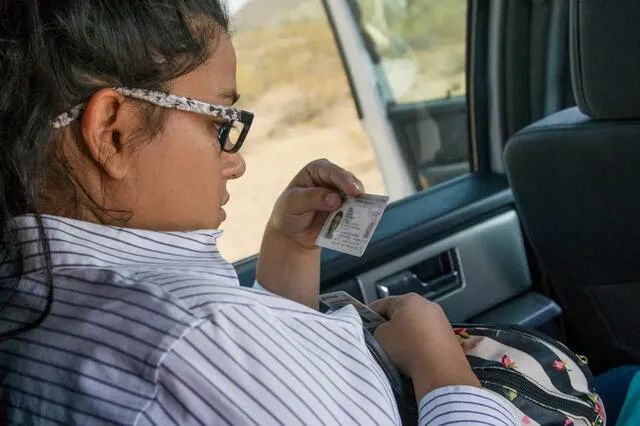
Prepare for the worst: Selena Ramirez is carrying her brother carlos martinez’s Mexican voter card. She said that if they found his body, it might help to identify him.
Their mother moved back to Canaria in Sonora a few years ago. Ramirez said that after Martinez was deported, he moved in with his mother. But he is eager to return to Phoenix.
"He doesn’t want to stay in Mexico anymore," Ramirez said. "He doesn’t like it. He feels very strange. "
But it is a felony to illegally re-enter the United States after being deported. This may explain why he decided to embark on such a distant and dangerous route.
Martinez stocked up on food and water before smuggling. According to him, he will cross the border with eight or nine other people.
He was probably put down by a snakehead near the 19-kilometer sign on Mexico Highway 2, about 12 miles west of Sonoita, and then passed there. There are roadblocks here, too, but they are used to stop vehicles from passing, and people can easily climb over them.
What is even more frightening is the other side. It takes 80 miles to reach the most common smuggling destination-Gilabend. It may take 7 to 10 days to cross the mountainous desert terrain on foot.
马丁内斯越境两天后,拉米雷斯接到了他的一个同伴打来的电话。
他告诉她马丁内斯开始感到不舒服。他在呕吐。一开始他说他要向边境巡逻队自首。然后他决定继续走下去。那是这个人最后一次见到他。
接下来的两天,拉米雷斯一直在打电话,想知道她哥哥发生了什么事。她给边境巡逻队、移民和海关执法局、管风琴仙人掌国家纪念碑和墨西哥领事馆打了电话。
没有找到他的任何记录。
“我一直希望他被移民局拘留了,但他没有,”拉米雷斯说。“我们不会失去希望。除非我看到我哥哥的尸体,否则他就是活着的。”
“骨头!”
6月23日上午11点多一点,人道主义团体“不再有死亡”(No More Deaths)的志愿者们排起了长队。
他们走在沙漠的灌木丛中,低着头,眼睛扫视着地面,在基诺峰以南进行网格搜索,移民报告说在那里看到了一具尸体,可能是拉米雷斯哥哥的尸体。
一个志愿者刚刚发现了一根骨头。队伍停了下来。
其中一名志愿者是一名兽医。她告诉该组织领导人斯科特·沃伦(Scott Warren),它看起来像一块大腿骨。但它看起来太小了,不像是人类。她说,它可能来自一头鹿。
Warren used GPS to locate the place. He also took several photos, and planned to send the coordinates and photos to the Pima County Forensic Medicine Office, so that officials could determine whether the bones came from animals or humans.
Volunteers continue to search.
Then the group stopped to rest in a sparse shade.
This place is full of fragments left by stowaways when they are resting: empty tuna cans, food wrapping paper, torn clothes, backpacks, and black plastic gallon kettles specially sold to immigrants in Mexico, because they are not reflective and will not attract the attention of the border patrol.
As part of the organization’s efforts to prevent the death of immigrants, No More Death volunteers regularly put down fresh water and bagged beans in the same place.
Warren said that when the stowaways arrived here, they had walked for a day or two, 15 to 20 miles from the border, but 60 miles from Gilabend, and they had to walk for five to seven days.
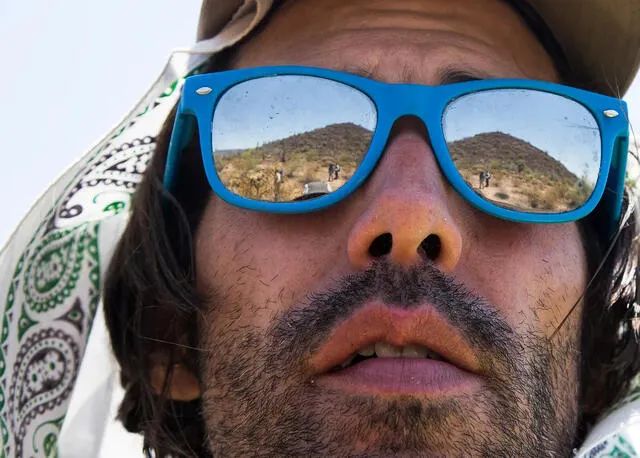
Scott Warren of the humanitarian organization No More Death and other volunteers went to Arizona Organ Cactus National Monument to find the remains of immigrants.
The temperature that day was above 105 degrees. "You need more than one gallon of water a day, maybe close to two gallons," Warren said. "If you calculate, you have to prepare 15 gallons of water. That is about 130 pounds. You really can’t carry so much water. "
This helps to explain why so many stowaways have died.
No one knows how many bodies have not been found, but there may be thousands.
The summer heat exhausted the volunteers’ energy, so they decided to get back in the car and park it near the rescue lighthouse of the border patrol two miles away.
Suddenly, a man appeared out of nowhere, jumped out of the bushes and waved his arms.
This is an immigrant.
"We have water," a volunteer shouted in Spanish.
"We are lost," the man shouted. "We need help."
On this day, Irineo Mujica followed the "No More Death" group, hoping to help find Martinez. He and Martinez met in an immigrant shelter in Sonoita.
While other volunteers were waiting under a tree, mujica followed Warren and the stowaway to a small white leaf tree.
Another stowaway was lying in the shade on the ground. They have no water.
While the volunteers were treating the two stowaways, a third person came. He went to look for water earlier. He told mujica that he had seen a body when he was chased by the border patrol not far from the foot of the mountain the day before.
Muhika said that after receiving help, these immigrants decided to return to Mexico on foot instead of turning themselves in. So the volunteers left them under the tree and went back to the car by themselves.
Search again
Four days later, on June 27th, mujica decided to go back and look for it himself. This time he brought Ramirez.
Less than an hour after the search, Ramirez was a little overwhelmed. She often stops to have a rest and drinks some hot water.
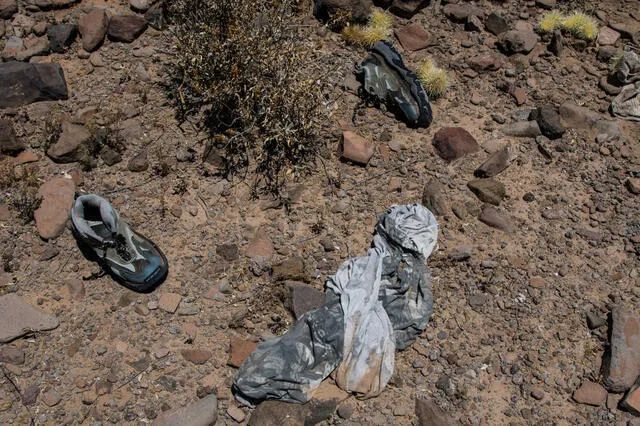
During the search, Ramirez found the shoes and clothes left by a cross-border person in Organ Cactus National Memorial Park.
She tried to take a few sips of drink. But at the high temperature of 108 degrees Fahrenheit, the taste of electrolyte drinks is disgusting. She left it on a rock, next to which was a deep beach full of debris discarded by immigrants.
Ramirez said, "I left it there for those who need it more than I do."
This area is full of migration paths across the desert.
When she reached a ridge, Ramirez met a tragic scene. Someone tore off all his clothes-shoes, socks, shirts, trousers, underwear-and threw them on the rocks, which is evidence of someone’s extreme pain.
Ramirez looked at his shoes. She concluded that these things were not her brother’s. He is wearing white shoes. These shoes are all black.
The probability of going out by yourself is zero.
Agent Daniel Hernandez parked his border patrol car next to Highway 85. He listened to the crackle of the radio and explained why this part of the border was so dangerous.
First of all, the terrain here is very barren, and immigrants can’t cross it without the help of snakeheads, so they are tantamount to handing their lives into the hands of strangers. If stowaways are injured or sick, snakeheads will leave them behind.
He said: "The probability of them going out by themselves is zero."
What about Trump’s border wall? Does this help prevent immigrants from dying?
Hernandez said that he would not comment on political issues. But he said that fences alone can’t stop people from crossing the border illegally.

Roger Antonio Paz Leiden, a 28-year-old man from Nicaragua, was arrested by border officials 10 days after crossing the desert in southern Arizona.
"The wall is to create time for agents to deal with illegal entry. It can’t stop anyone outside. "
Later that day, Hernandez heard someone calling on the radio. A helicopter of the Department of Homeland Security found two stowaways running south at Charlie Bell Pass while patrolling in the air.
After chasing for a short time on foot in the desert, the agents caught one of the immigrants.
The 28-year-old immigrant said that his name is Roger Antonio Paizleton and he is from Nicaragua. He walked in the desert for 10 days, trying to reach Gila Bend. He said that he saw at least 10 bodies along the way.
It’s almost one o’clock in the afternoon The sun is high above. Now the temperature is close to 111 degrees Fahrenheit. Ramirez and mujica have been looking for it for two and a half hours. Ramirez also began to feel unwell.
"I feel very anxious," she said. "I feel cold."
Signs of dehydration.
Now it’s four miles to get back to the truck. When they arrived, Ramirez was already limping. She has blisters on her feet. Her head hurts.
She climbed into the back seat and took off her hat and glasses.
After taking some painkillers and drinking more water, she began to feel much better.
She said: "I don’t know how they can persist in walking for seven or eight days. It is their dream to come to America. This is their motivation to move on. They want to enter the land full of opportunities. I walked for four or five hours, and I can’t walk any further. "
On the way back to Aqiao, Ramirez called his mother who was waiting for news in Sonoita.
Ramirez told her in Spanish: "We didn’t find anything."
Photo of the baby girl next to the body
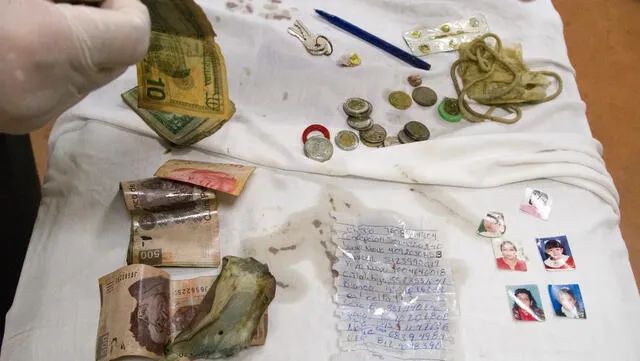
The remains of the deceased counted by the medical examiner’s office.
A corpse was lying on a stretcher in the corpse collection office of Pima County Forensic Medicine Office, and death investigators Jean Hernandez and Travis hairston were counting the relics of the deceased.
Every time hairston says something, Hernandez will input it into the computer.
A green camouflage shirt. A Nike hoodie. Two pairs of socks. Blue underwear. Blue jeans. Black belt. A water bottle, still full. All kinds of packaged food. Three mobile phones and a charger.
Investigators didn’t find any identification. But the dead immigrant wore a white plastic ring with "Dany Karen" engraved on it. These personal belongings may help investigators identify the body.
In the morning, the border patrol found the body while chasing seven immigrants. The body was located under a tree in a desert area about 30 miles southwest of Tucson.
尸体被运到皮马县法医办公室,所有在亚利桑那州南部发现的移民尸体最后都在那里。
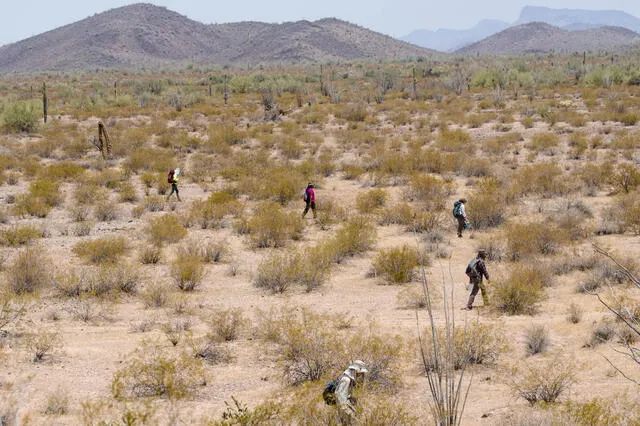
在亚利桑那州阿乔附近的管风琴仙人掌国家纪念公园,志愿者分散开来,寻找偷渡者的尸体。
赫斯后来说,当天运来的尸体被确认为来自危地马拉的31岁移民阿尔弗雷多·巴勃罗·戈麦斯。遗体被送往殡仪馆,送回危地马拉。
但其他遗骸就不那么容易辨认了。那些在6个月到1年还未被确定身份的尸体,最后被火化并安葬在图森公墓。
公墓里挤满了身份不明的移民。
埃尔南德斯说:“不管出于什么原因,边境越军事化,人们就越是要往沙漠深处走,这已经不是什么秘密了。”
突然,有人敲了埃尔南德斯的门。
海尔斯顿招呼了一声:“又有案子了。”
这一次,尸体位于银铃矿,这个地方在图森以西60英里,靠近托霍诺奥德姆保护区的边界。
在死者的裤子口袋里,海尔斯顿发现了一张6月6日从墨西哥城飞往埃莫西约的登机牌。
海尔斯顿还发现了一个十字架、一些墨西哥比索、五张20美元钞票、一张墨西哥驾照和一张墨西哥选民卡。选民卡上的名字是胡安·曼纽尔·桑多瓦尔。他现年46岁。
Finally, hairston took out seven small photos, probably of the deceased’s family. Four of the photos are children: a boy and three girls. Two are women: one is about his age, and the other is older, probably his mother. The last photo is bigger than the others.
The photo is of a baby girl wearing a pink sweater with long black hair. Black eyes looked straight at the camera.
She seems to be crying.
reunite
On July 17th, a group of stowaways found a body in the desert not far from where Martinez was last seen. These people carried their bodies for more than 10 miles back to Mexico, and then called mujica.
The male body was badly decomposed and unrecognizable. But mujica thinks that these remains may belong to Martinez, a missing immigrant, because there are several clues. White and neat teeth indicate that the body belongs to a young man. He has black hair; The brand of camouflage clothes and underwear he wears is the same as that Martinez wore before crossing the border.
A few days later, Selena Ramirez’s mother took a bus for six hours to identify the body, and she also provided her own DNA sample.
Two months later, the DNA test results gave the family an answer. That’s really Selena’s brother.
Original title: "Deep | In this desert in the United States, stowaways die and die constantly"
Read the original text